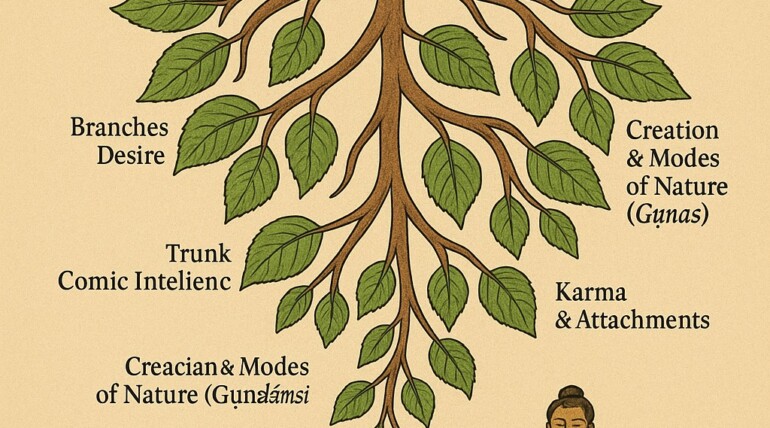The Transformative Power of Mahavakyas in Advaita Vedanta
1. The Gateway to Liberation Through Great Sayings
In Vedanta—especially in Advaita Vedanta—it is extremely important to clearly understand the meaning of the four Mahavakyas (Great Sayings). Scholars define a Mahavakya as a sentence that reveals the highest spiritual truth. What is that truth? At first glance, the jiva (individual soul) and Brahman (the Supreme Reality) appear to be two separate entities. But in reality, they are one and the same. This realization dissolves the bondage of worldly suffering (samsara). You might ask: does mere understanding really free one from bondage? In Vedanta, “understanding” means that a deep conviction arises in the mind. At that level, we no longer see the jiva, the world, or even God as separate forms—only pure existence remains. This existence is formless, all-pervading. When our awareness merges with that, it too becomes formless and limitless. This realization is called Advaitic knowledge, and it is the key to true freedom.
2. What Are the Mahavakyas?
What are these Mahavakyas, and what do they mean? Do they each have a different meaning? If so, how can they point to the same ultimate truth? The four statements are:
- Ayam Atma Brahma – This Self is Brahman.
- Prajnanam Brahma – Consciousness is Brahman.
- Tat Tvam Asi – You are That.
- Aham Brahmasmi – I am Brahman.
3. Four Forms, One Essence
Although they may appear distinct, all four convey the same essence: Brahman is pure knowledge, pure being. When this is understood, the duality between knower (jiva) and known (the world) dissolves. Only pure awareness remains. For example, “Ayam Atma Brahma” affirms that this individual soul is none other than Brahman, implying that the separateness of life is illusory. “Tat Tvam Asi” is part of a larger sentence that reveals the same—”You are That.” It negates the false idea that the world is separate from Brahman. Once the first three Mahavakyas establish that the jiva and world are not ultimately real, a doubt arises: Is Brahman something we can directly experience or just a theory? The fourth Mahavakya, “Aham Brahmasmi,” settles this by stating clearly—I am that very Brahman. Thus, all four together form a single, unified teaching.
4. Progressive Revelation for the Dualistic Mind
It’s hard for the human mind—accustomed to duality—to grasp non-duality at once. So, these Mahavakyas approach us gradually: the first two deny the independent reality of the jiva and the world; the third points to what Brahman truly is; the fourth reveals that our very self is none other than Brahman. In Vedantic language, this is called apavada samanadhikaranya: first, we negate the false (apavada), then we reveal the identity (samanadhikaranya). It’s like seeing a rope in the dark but mistaking it for a snake. The illusion is not removed by arguing; it disappears the moment we realize, “It is not a snake—it is a rope.” Similarly, the feeling “I am this body” traps us in a cycle of birth and death. But the truth is, we are not limited to this body—we are the all-pervading consciousness, Brahman. When this is realized, our mistaken identity is corrected, and we are liberated from suffering.
5. Beyond the Illusion of the World
Though this realization helps remove the limited sense of “I,” the sense of the world’s reality may still remain. Vedanta tackles this too. It shows that everything is one essence, Brahman, and unites both the individual and the universe in that truth. The Mahavakya “Tat Tvam Asi” leads us to this realization. Advaita assures us that through deep inquiry into these Mahavakyas, this non-dual experience can be achieved, especially when culminating in “Aham Brahmasmi”—the realization that the self and Brahman are one.
6. Shankara’s Authority on Realization Through Words
To support this, Adi Shankaracharya writes in his commentary on the Brahma Sutras: “Vakyartha jnana eva brahmaavagatih”—realization of Brahman comes through the correct understanding of the meaning of the Mahavakyas. As we reflect deeply on these great statements, the illusion that the jiva and world are separate dissolves, and the certainty arises that we are that non-dual awareness, Brahman. This conviction is called Brahmakara Vritti—a mental state completely absorbed in the idea “I am Brahman.” Like Brahman, this awareness is also formless and infinite.
7. The All-Pervading Presence of Pure Awareness
This realization spreads in three ways: internally, externally, and through all forms. Think of a golden ornament. Its outer surface is gold, its inner substance is gold, and its shape also reflects gold. There is no place where gold is absent. The ornament is nothing but gold, even though it appears as different forms. Likewise, our awareness is the essence of all experience. What appears as the world or the gods is really just the manifestation of that one undivided consciousness—Brahman.
8. The Mutual Dependence of Jiva and Jagat on Brahman
Our present self-awareness is just one form of that pure consciousness. The entire world exists because of this awareness, and vice versa. If the world and jiva appear real due to mutual dependence, the deeper truth is that both rest upon Brahman, just as a seed and tree rest upon the soil. The seed and tree may change, but the soil remains. Likewise, the gods of the world are not real independently. Brahman alone is real. Even though our ignorant minds perceive the world as separate, the Mahavakyas guide us back to the truth.
9. Reclaiming the Self through Mahavakya Contemplation
By listening to and contemplating these Mahavakyas, we come to recognize that our true self is not the body or mind but the all-pervading awareness. Then, everything else—what we thought of as the world—becomes a manifestation of that awareness. This is the goal of the Mahavakyas: to help us realize the non-dual Self, which is the only true resolution to human suffering. This is also the ultimate purpose of human life.



